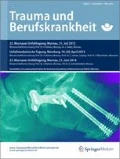Zusammenfassung
Jeder zweite angestellte Tänzer/-in verletzt sich mindestens einmal im Verlauf einer Saison im Rahmen seiner beruflichen Tätigkeit akut. Dennoch ist der zu behandelnde Arbeitsunfall eines Tänzers/-in innerhalb der Praxistätigkeit in der Regel selten. Die Erstbehandlung ist – wie in anderen Berufen auch – maßgeblich für die Rehabilitation. Für die Dokumentation sind ein Grundverständnis der arbeitsspezifischen Belastungen im professionellen Tanz und ein tänzerisches Basisvokabular sehr hilfreich. Weiterhin werden meist Grundkenntnisse der englischen Sprache benötigt, da die deutsche Sprache für die überwiegende Mehrzahl der angestellten Tänzer/-innen eine Fremdsprache darstellt.
Abstract
One in two professional dancers sustains an acute injury in an occupational accident during the course of an annual work period. Nevertheless, in a medical surgery it is usually extremely rare to be confronted with an occupational accident of a professional dancer. The primary treatment is – similar to other occupations – decisive for the rehabilitation, though. Basic knowledge of the work-specific distress and a basic dancers’ vocabulary are beneficial. In addition to that, basic knowledge of the English language is required as German is a foreign language for the majority of professional dancers.


Literatur
Air M, Rietveld ABM (2008) Dance-specific, graded rehabilitation: advice, principles, and schedule for the general practitioner. Med Probl Perform Art 23(3):114–119
Arendt YD, Kerschbaumer F (2003) Verletzungen und Überlastungserscheinungen im professionellen Ballett. Z Orthop Ihre Grenzgeb 141(3):349–356
Byhring S, Bo K (2002) Musculoskeletal injuries in the Norwegian National Ballet: a prospective cohort study. Scand J Med Sci Sports 12(6):365–370
Cassela MC, Ploski C, Sullivan E, Micheli LJ (1999) Transition dance class: rehabilitation through dance. J Dance Med Sci 3(4):139–144
Drees P (2000) Verletzungen beim professionellen Balletttanz. Z Orthop Ihre Grenzgeb 138 (3):2–6
Fuchs E, Hess H, Kunz M (2003) Injuries and chronic damages in classic ballet. Sportverletz Sportschaden 17(3):123–131
Kelman BB (2000) Occupational hazards in female ballet dancers. Advocate for a forgotten population. AAOHN J 48(9):430–434
Motta-Valencia K (2006) Dance-related injury. Phys Med Rehabil Clin N Am 17(3):697–723
Nilsson C, Leanderson J, Wykman A, Strender LE (2001) The injury panorama in a Swedish professional ballet company. Knee Surg Sports Traumatol Arthrosc 9(4):242–246
Rossol M, Hinkamp D (2001) Hazards in the theater. Occup Med 16(4):595–608
Scharff-Olson MR, Williford HN, Brown JA (1999) Injuries associated with current dance-exercise practices. J Dance Med Sci (3)4:144–150
Schon LC, Weinfeld SB (1996) Lower extremity musculoskeletal problems in dancers. Curr Opin Rheumatol 8(2):130–142
Stretanski MF, Weber GJ (2002) Medical and rehabilitation issues in classical ballet. Am J Phys Med Rehabil 81(5):383–391
Wanke EM (2007) Zu Risiken und „Nebenwirkungen“ des Tanzes. Tanzmedizin in Ausbildung und Beruf. Transcript, Bielefeld, S 161–170
Wanke EM (2008) Arbeitsbedingte Verletzungen und Erkrankungen. In: Exner Grave E (Hrsg) Tanzmedizin. Schattauer, Stuttgart New York
Wanke EM (2009) Rahmenempfehlungen zur Prävention von Unfällen im professionellen Bühnentanz. Deutsche Gesetzliche Unfallversicherung, Berlin
Wanke EM, Mill H (2006) Arbeitsmittel Körper – Zum Auftreten von Arbeitsunfällen im professionellen Bühnentanz. Sicherheitsbeauftragter 3:14–15
Interessenkonflikt
Der korrespondierende Autor gibt an, dass kein Interessenkonflikt besteht.
Author information
Authors and Affiliations
Corresponding author
Rights and permissions
About this article
Cite this article
Wanke, E., Wanke, A., Uibel, S. et al. Arbeitsunfall im professionellen Bühnentanz. Trauma Berufskrankh 13, 131–139 (2011). https://doi.org/10.1007/s10039-010-1694-8
Published:
Issue Date:
DOI: https://doi.org/10.1007/s10039-010-1694-8

